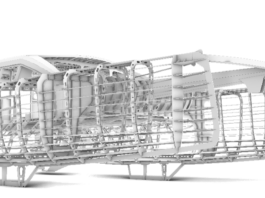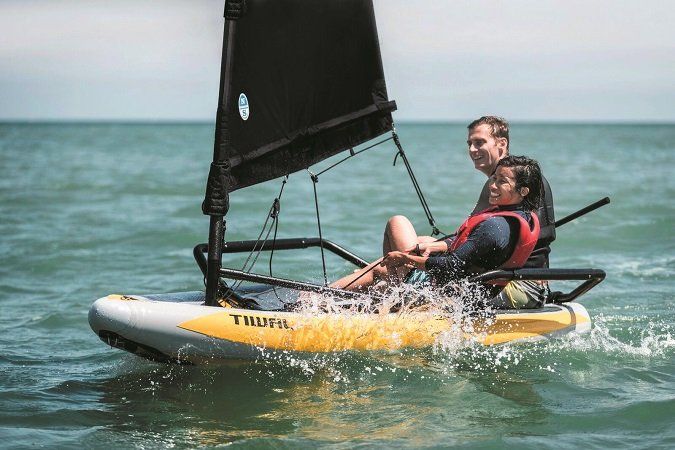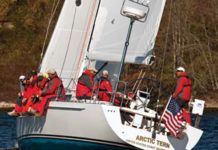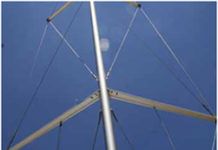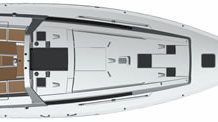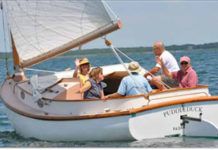New Boat Review: A Look Inside the New Leadership 44
The U.S. Coast Guard Academy recently received its newest sail training boat: the Leadership 44. Built by Morris Yachts, a company best known for high-end, custom sailboats, the Leadership 44 was designed by David Pedrick, whose resume includes America’s Cup boats and many capable cruisers. The Leadership 44 has all the necessary features of a 24/7 underway workboat—offshore sleeping berths, ventilation in rough weather, a galley and head that work well underway, and a sail plan that’s efficient and easy to handle. With a displacement of 26,000 pounds, the L44 is strong and stiff, yet reasonably lightweight for a boat of that size. Civilian versions of the design will be making their way to the market soon and would be worth considering for bluewater cruising duty.
Hunter Factory Blends Old and New Technology
The Hunter 33 is built in Alachua, Fla., using high-quality resins and laminates and conventional open molding hand-laminating processes.
Funding the Dream
In the June 2001 issue, Practical Sailor looked at financing boats and recommended that prospective boat buyers “stick with the pros.” We recently set out to see what had changed in boat financing since the 2008 U.S. financial crisis. After interviewing industry experts and related organizations on the state of the marine lending and boating industries, we assumed a boat-buyer’s role and sought financing help from marine loan specialists, large banks, and small lenders. We looked at cash versus financing, borrowing against your home, finance products, rates on boat loans, collateral on the loans, insurance issues, pre-approvals, repossession, and borrower qualifications.
A Practical Look at Sailboat Cockpit Design
A sailboat cockpits design and layout can determine the process of boat-handling tasks, including everything from steering and sail trimming to what goes on when its time to reef. Weve found that many cockpits are optimized for at-anchor enjoyment instead of underway usability, so boat shopping should include close scrutiny of how essential sailing and boat-handling tasks will be accomplished. Make sure that the cockpit of the boat you are about to buy is in keeping with the mission of the rest of the boat-whether youre a marina hopper, a club racer, or an offshore cruiser. Our recent survey of cockpits covers the highs and lows of cockpit design for various types of sailboats, and also includes a DIY guide to rating cockpit ergonomics to help your boat-shopping process.
Building a New Beneteau
The building process that gives rise to the Beneteau Oceanis 41 begins in France, where digital design files stir a five-axis cutter to life, and 3D foam patterns begin to take shape. These robotically cut male plugs are used to fabricate female molds, often referred to as “tools.” The hull and deck are the major molds, but there are often 20 or more smaller tools created that are used to mold other interior and exterior components—ranging from locker lids to a plinth for the marine head. All of the tooling for each Beneteau is made in the prototype shop in France and is shipped to factories around the world.
Boat Review: Marshall 22 Catboat
The stout Marshall 22, in production since 1965, rekindles the romance of shoal-water sailing. As a weekender or coastal cruiser, the Marshall has much to recommend it, especially to those who can fully exploit its shallow draft. Drawing less than 6 feet, the Marshall opens up new cruising grounds for those willing to put in a little extra effort. New boat prices range from the base $76,900 to around $90,000. Used boats range from around $18,000 to $70,000. Practical Sailor recommends a survey for the purchase of all used boats.
Practical Sailor Reviews Seven Performance-Sailing Dinghies
With summer upon us, light, quick sailing dinghies that are easy to sail and easy to transport make summertime on the water a blast. Practical Sailor reviews some of the perennial favorites-the Optimist, Sunfish, Hobie, and Laser-and looks at how newcomers like Bic Sports Open Bic match up. Testers also review a do-it-yourself sailing dinghy kit, the Eastport Pram from Chesapeake Light Craft, and Hobies newest catamaran, the Bravo, a quick-to-launch beach cat with plenty of get-up-and-go. We also take a look at Laser Performances newest club trainer/racer for the wee sailors, the Bug.
In-Boom Furling: Five Systems
There's no perfect solution to boom furling. It's not an easy bit of engineering. Still, all the systems on the market continue to mature. Schaefer's new offering looks like a good bet for medium-sized boats.
1988: A Better Year for Buyers and Sellers
About a year ago, I read an article that warned of “the coming crash in sailboat prices.” I didn’t believe it then, and nothing has happened in the last year to make me change my mind. In fact, while no one is ready to declare that the “soft” market for new sailboats is over, there are numerous indications that sales are up, and that used boat prices are beginning an upward spiral.
How to Restore Teak Wood on Boats
Probably nothing can make or break the appearance of a fiberglass boat more quickly than the appearance of the exterior teak trim. Contrary to popular belief, teak is not a maintenance-free wood that can be safely ignored and neglected for years at a time. Though teak may not rot, it can check, warp, and look depressingly drab if not properly cared for.


































